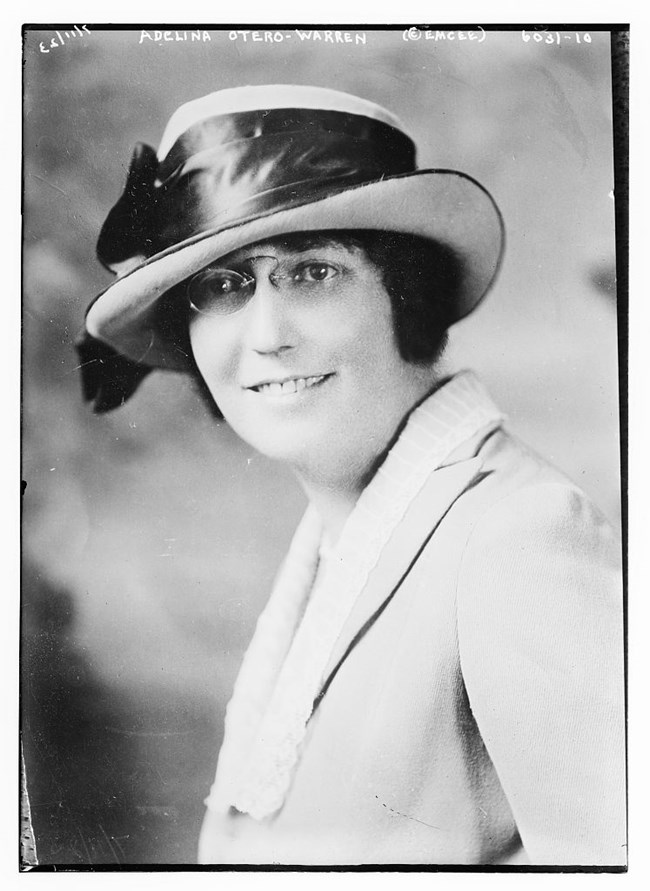Part of a series of articles titled Curiosity Kit: Nina Otero Warren.
Article
Learning from Nina Otero Warren
These activities were researched and written by Alison Russell a NCPE intern with the Cultural Resources Office of Interpretation and Education.

Background:
Nina Otero-Warren fought for equality in voting, education, and health. Born in 1881, she traced her roots in New Mexico to early Spanish occupation. Her father was killed in a wave of violence between incoming Anglo settlers and existing Spanish settlers when she was two years old. Her mother remarried an Englishman in 1886, creating a multicultural household.
Otero-Warren married Rawson D. Warren in 1907. She was unhappy and they divorced two years later. It was at this point in her life that she became active in politics. Her work towards women’s suffrage caught the eye of Alice Paul. Paul asked Otero-Warren to head the New Mexico chapter of the Congressional Union for Woman Suffrage (later the National Women’s Party.) In 1918, in addition to her work for suffrage, Otero-Warren became the Superintendent of Public Schools in Santa Fe County. She worked to improve education for the Hispano and Native American communities. She criticized the federal government’s Indian school system for the abusive conditions and destruction of Native culture. Otero-Warren also ran for the House of Representatives in 1921. She won the Republican nomination but lost the election by less than nine percent.
As she continued in public service, she and her companion, Mamie Meadors, established a homestead called “Las Dos” in the 1930s. In 1947 they also opened a real estate and insurance company. In the 1930s Otero-Warren also began publishing her writing. She focused on the history and life of Hispano Americans in the Southwest. She died in 1965 in her childhood home in Santa Fe. To learn more about Nina Otero-Warren, read this article or visit The Places of Nina Otero-Warren.
Objectives
-
Identify the benefits and drawbacks of bilingualism and biculturalism. Debate the place of bilingual education in schools.
-
Identify and analyze the impacts of a culture or group on your community
-
Define substantive and descriptive representation. Evaluate the different forms of representation in national government.
Inquiry Question
How does your identity reflect your culture and community? How can your community shape and support your endeavors?
Activity 1: Bilingual Education
Nina Otero-Warren made sure to include the Hispano community when lobbying for women’s suffrage in New Mexico. She fought to publish all suffrage materials in Spanish as well as English. She carried this mission into Santa Fe schools as superintendent. She worked to honor the heritage of Anglo, Native American and Hispano students. This included bilingual education, teaching in both Spanish and English.
According to the U.S. Census Bureau, 60 million Americans speak a language other than English at home. 40 million speak Spanish in 2017.
Have a debate: Should all students learn Spanish as well as English in schools? What are the advantages and disadvantages of creating bilingual materials or bilingual education? What about other languages spoken in the United States? For a challenge, assign the pro position and the con position regardless of participants' personal beliefs. The important thing is to marshal evidence, lay out your reasoning clearly and weigh each side’s position. After your debate, share how you really feel about the issue and why you think it’s important.
Want more information? This article highlights the history and arguments of bilingual education.
Activity 2: Many cultures make a community
Nina Otero-Warren wrote several articles and a book about the Spanish heritage of America’s Southwest. What cultures have contributed to your area? In many communities, the influence of different people, immigrant or indigenous, is visible in the architecture, food, languages, and customs. What do you see when you look around? Where do you think that comes from?
Choose a cultural group in your area and do a little research about how they contributed to the community. It can be a culture you belong to, like Nina Otero-Warren writing about her own Spanish heritage, or a different culture. Either way, think about how that culture has affected your life through its contribution to your community.
Once you’ve researched, share what you’ve learned. You can do this by talking with your family and friends or by writing a short paragraph for a local history or news site. Otero-Warren thought it was important to share the contributions of Hispano-Americans to the southwest. How can learning about the contributions of a culture prompt a new appreciation of your home? After doing your research, how does it impact the way you look at American culture as a whole?
Activity 3: Types of Representation
In 1921, Nina Otero-Warren became the first Latina to run for Congress. Although she lost, it was an important milestone in the effort to make sure everyone is represented in our government. Ileana Ros-Lehtinen was the first Latina elected to Congress in 1989. Since then, the U.S. Congress has continued to become more diverse.
Political scientists have categorized two types of representation. Substantive representation is when politicians share the values and political positions of groups they represent. Descriptive representation refers to shared backgrounds and demographic characteristics of people and their representatives.3 What are the benefits of substantive and descriptive representation? How do each impact the ways in which laws meet the needs of the county?
Go to your Congressperson’s website (Many can be accessed through the House of Representatives or Senate homepages). Do they represent you and your family descriptively? Do they have a similar background to you? Do they represent you substantively? How are your ideas about political issues similar? How do you well do you see your Congressperson representing you?
Last updated: August 8, 2021
